Encyclopedia Dubuque
"Encyclopedia Dubuque is the online authority for all things Dubuque, written by the people who know the city best.”
Marshall Cohen—researcher and producer, CNN
Affiliated with the Local History Network of the State Historical Society of Iowa, and the Iowa Museum Association.
GERMANIA HALL
Being written
GERMANIA HALL. For its size, the old Saengerbund Hall was a short-lived structure in Dubuque. Located on a piece of land approximately 80' x 200,' the structure erected in 1896 and made entirely of wood lasted less than five years. (1) In May 1896, Dubuque County Democrats urged that it be offered as a state for the state convention the next year instead of the GRAND OPERA HOUSE. (2)
One of the popular events for which the building was used were the pure food shows at which producers handed out free samples to advertise themselves. Ironically it was the paper wrappers for the food which littered the floor that finally resulted in the decision to demolish the building. (3)
A rock wall on the corner of Heeb and 22nd STREETS provided "cheap seats" for youngsters wanting to see inside. On evenings when prize fights were scheduled, this location was especially prized. Windows at the top of the wall provided a prime view of the padded ring. One of the most remembered times occurred from August 29-31, 1899 during the carnival held in conjunction with a racing meet at the DUBUQUE DRIVING PARK. The fights were organized by the DUBUQUE ATHLETIC ASSOCIATION. Among the fighters were Jack Root and George Byers who fought for the middleweight championship of the United States. Tommy White and Eddie Santry competed for the lightweight championship of the world. Tommy Ryan and Jack Moffatt fought for the welterweight championship while George Kerwin and James Sellers competed for the lightweight championship of Iowa. Railroads offered half-fare tickets to Dubuque to encourage attendance resulting in crowded depots. (4)
Additional seating provided for the 1899 events increased the capacity of the auditorium from its usual 5,000 to 6,000 spectators. General admission tickets ranged from $1.00 to $5.00 on the main floor. Seats costing $3.00 were located behind the more expensive seats with balcony seating costing $2.00. (5)
The auditorium featured a stakeless ring padded with felt located in the center of the building and high enough to be seen. This was covered with tightly pulled canvas which made the floor surface elastic. Special lighting allowed the operator to range the illumination from soft to "extraordinary brilliancy." (6)
Although the DUBUQUE SAENGERBUND used the building for social gathering and singing events, by 1901 nearly all traces of the building had been removed. (7)
By the time it had been demolished, fundraising for a new hall had been long underway.
Source:
1. "Old Saengerbund Hall, Site and Scene of Many a Prize Fight and Songfest, Lingers in Memory of Many a Dubuquer," Telegraph-Herald and Times-Journal, March 19, 1933, p. 5
2. "A Sure Thing," The Dubuque Herald, May 13, 1896, p. 8
3. "Old Saengerbund Hall..."
4. Ibid.
5. Ibid.
6. Ibid.
7. Ibid.


